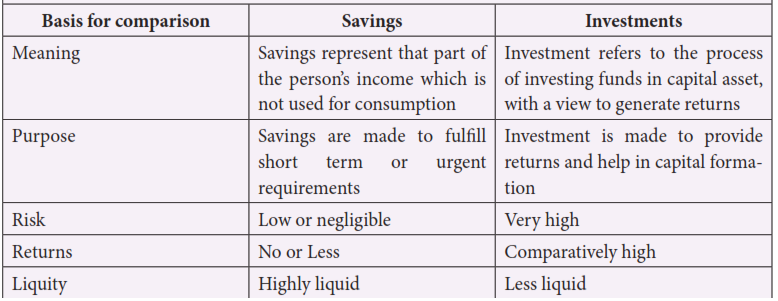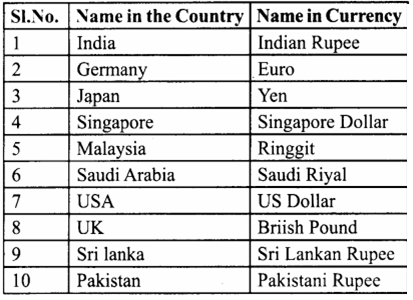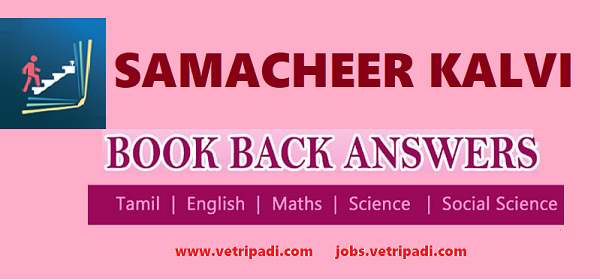8th Social Science – Economics Book Back
& Questions Answers (solution)
Term 1
1. Money, Savings and Investments
8th Social Science Economics Solutions Term 1 – Chapter 1 Money, Savings and Investments solutions – Tamilnadu Samacheer kavi – English Medium
I. Choose the correct answer:
- Which metals were used for metallic money?
(a) Gold
(b) Silver
(c) Bronze
(d) All the above
Answer: (d) All the above
2. Who introduced the paper money?
(a) British
(b) Turkish
(c) The Mugual Empire
(d) Mauryas
Answer: (a) British
3. The value of money is
(a) Internal value of money
(b) External value of money
(c) Both a & b
(d) None of these
Answer: (c) Both a & b
4. Which is the Bank Money?
(a) Cheque
(b) Draft
(c) Credit and Debit cards
(d) All the above
Answer: (a) Cheque
5. Pick out the incorrect one:
Investment can be made in different vehicle.
(a) Stock
(b) Bonds
(c) Mutual fund
(d) Pay tax
Answer: (d) Pay tax
6. Who is responsible for the collection and publication of monetary and financial information?
(a) Finance commission
(b) Finance Ministry
(c) Reserve Bank of India
(d) Auditor and Comptroller General of India
Answer: (c) Reserve Bank of India
II. Fill in the Blanks
- Online Banking is also known as ……………
- ……………. is what money does.
- The term of bank is derived from ……………. word.
- Value of money is meant …………….. of money.
- The Indian banking regulation act of ……………..
Answer:
- Net Banking
- Money
- old Italian word ‘banca’ or French word ‘banque’
- The purchasing power
- 1949
III. Match the following

Answer:
- iv
- v
- ii
- iii
- i
IV. Write the one word answer
- The word Money is derived from?
Answer:
The word Money is derived from Roman word “Moneta Juno”
2. Which bank gives to both short term and long term loans?
Answer:
Rural cooperative credit institutions.
V. Choose the correct statement
1.Barter system had many deficiency like –
I. Lack of double coincidence of wants
II. No difficulties of storing wealth
III. Common measure of value
IV. Indivisibility of commodities
(a) I and II is correct
(b) I and IV is correct
(c) I, III and IV is correct
(d) All are correct
Answer: (c) I, III and IV is correct
VI. Find out the odd one
- Recent forms of money transactions are
(a) Credit card
(b) Barter system
(c) Debit card
(d) Online banking
Answer: (b) Barter system
2. Effects of black money on economy is
(a) Dual economy
(b) Undermining equity
(c) No effects on production
(d) Lavish consumption spending
Answer: (c) No effects on production
VII. Write short answer
- What is the Barter System?
Answer:
A barter system is an old method of exchange. Barter system is exchanging goods for goods without the use of money in the primitive stage.
2. What are the recent forms of money?
Answer:
Plastic Money and E – Money
3. Short note on E – Banking and E – Money.
Answer:
1. E – Money:
Electronic Money is money which exists in banking computer systems and is available for transactions through electronic system.
2. E – Banking:
Electronic banking, also known as National Electronic Funds Transfer (NEFT), is simply the use of electronic means to transfer funds directly from one account to another rather than by cheque or cash.
4. What are the essential of Money in your life?
Answer:
Money is used as the source to fulfill basics needs as well as comforts in life. It gets people accommodation, clothes, food and other things which add to luxury in life. It is an important source to live a healthy life too.
5. What is the Value of Money?
Answer:
Value of money is the purchasing power of money over goods and services in a country.
6. What is the Commercial Bank and its types of Deposits?
Answer:
A bank that offers services to the General public and companies is a commercial banks. The types of deposits in a commercial bank are
- Time deposits. Example Fixed deposit
- Recurring deposit and Demand deposit Example Current Account and Savings Account.
7. What is Savings and Investment?
Answer:
- Savings represents that part of the person’s income which is not used for consumption
- Investment refers to the process of investing funds in capital asset, with a view to generate returns
8. What is meant by Black Money?
Answer:
Black Money is money earned through any illegal activity controlled by country regulations.
9. What are the effects of black money on economy?
Answer:
- Dual economy
- Tax evasion, thereby loss of revenue to government.
- Undermining equity
- Widening gap between the rich and poor
VIII. Write Brief answer
- What are the disadvantages of barter system?
Answer:
- Lack of double coincidence of wants,
- Common measure of value
- Indivisibility of commodities
- Difficulties of storing wealth
2. Write about the evolution of Money.
Answer:
Money has evolved through different stages according to the time, place and circumstances.
1. Commodity Money:
In the earliest period of human civilization, any commodity that was generally demanded and chosen by common consent was used as money. Example Goods like furs, skins, salt, rice, wheat, utensils, weapons etc. Such exchange of goods for goods was known as ‘Barter Exchange’.
2. Metallic Money:
With progress of human civilization, commodity money changed into metallic money. Metals like gold, silver, copper, etc. were used as they could be easily handled. It was the main form of money throughout the major portion of recorded history.
3. Paper Money:
(a) It was found inconvenient as well as dangerous to carry gold and silver coins from place to place. So, invention of paper money marked a very important stage in the development of money.
(b) Paper money is regulated and controlled by Central bank of the country (Reserve Bank of India). At present, a very large part of money consists mainly of currency notes or paper money issued by the central bank.
4. Credit Money or Bank Money:
(a) Emergence of credit money took place almost side by side with that of paper money. Example Cheque.
(b) The cheque (known as credit money or bank money), itself, is not money, but it performs the same as functions of money.
5. Near Money:
The final stage in the evolution of money has been the use of bills of exchange, treasury bills, bonds, debentures, savings certificate etc.
3. What are the functions of Money? and explain it.
Answer:
Functions of money are classified into Primary or Main function, Secondary function and Contingent function.
Primary or main functions:
The important functions of money performed in very economy are classified under main functions:
1. Medium of exchange or means of payment – Money is used to buy the goods and services.
2. Measure of value – All the values are expressed in terms of money it is easier to determine the rate of exchange between various type of goods and services.
Secondary functions:
The three important of secondary functions are
1. Standard of deferred payment – Money helps the future payments too. A borrower borrowing today places himself under an obligation to pay a specified sum of money on some specified future date.
2. Store of value or store of purchasing power – Savings were discouraged under barter system as some commodities are perishable. The introduction of money has helped to save it for future as it is not perishable.
3. Transfer of value or transfer of purchasing power – Money makes the exchange of goods to distant places as well as abroad possible. It was therefore felt necessary to transfer purchasing power from one place to another.
Contingent functions:
- Basis of credit
- Increase productivity of capital
- Measurement and Distribution of National Income
4. Explain the types of bank Deposits.
Answer:
1. Student Savings Account:
There are savings accounts some banks offer specifically for young people enrolled in high school or college, and they main feature more flexible terms such as lower minimum balance requirements.
2. Savings Deposits:
Savings deposits are opened by customers to save the part of their current income. The customers can withdraw their money from their accounts when they require it. The bank also gives a small amount of interest to the money in the saving deposits.
3. Current Account Deposit:
Current accounts are generally opened by business firms, traders and public authorities. The current accounts help in frequent banking transactions as they are repayable on demand.
4. Fixed Deposits:
Fixed deposits accounts are meant for investors who want their principle to be safe and yield them fixed yields. The fixed deposits are also called as Term deposit as, normally, they are fixed for specified period.
5. What are the difference between savings and investment?
Answer:

6. What are the effects of black money on economy?
Answer:
Effects of Black Money on economy
- Dual economy
- Tax evasion, thereby loss of revenue to government.
- Undermining equity
- Widening gap between the rich and poor
- Lavish consumption spending
- Distortion of production pattern
- Distribution of scarce resource
- Effects on production.
IX. Intext Hots
- If there is no invention of money – Imagine.
Answer:
Money is one of the most fundamental inventions of mankind. “Every branch of knowledge has its fundamental discover”. In mechanics, it is the wheel, in science fire, in politics the vote. Similarly in economics, in the whole commercial side of Man’s social existence, money is the essential invention on which all the rest is based.
Intext Activity
- Fill up the following Table: Answer:

Tags:
8th social guide samacheer kalvi,samacheer kalvi 8th books guide social science,social guide for 8th standard samacheer kalvi,samacheer kalvi guru 8th social guide,8th standard social guide samacheer kalvi,samacheer kalvi 8th social guide pdf,8th social guide tamil medium samacheer kalvi,8th social guide tamil medium samacheer kalvi,samacheer kalvi 8th books guide social science,samacheer kalvi guru 8th social guide,samacheer kalvi 8th social guide pdf,8th standard social guide samacheer kalvi,8th social guide tamil medium samacheer kalvi,8th social guide tamil medium samacheer kalvi,social guide for 8th standard samacheer kalvi,samacheer kalvi 8th books guide social science,samacheer kalvi guru 8th social guide,social guide for 8th standard samacheer kalvi,samacheer kalvi 8th social guide pdf,8th standard social guide samacheer kalvi,samacheer kalvi 8th books guide social science,samacheer kalvi guru 8th social guide,social guide for 8th standard samacheer kalvi,8th social guide tamil medium samacheer kalvi,8th standard social guide samacheer kalvi,8th social guide tamil medium samacheer kalvi,samacheer kalvi 8th social guide pdf,samacheer kalvi 8th books guide social science,social guide for 8th standard samacheer kalvi,samacheer kalvi guru 8th social guide,8th social guide tamil medium samacheer kalvi,8th standard social guide samacheer kalvi,samacheer kalvi 8th social guide pdf,8th social guide tamil medium samacheer kalvi,samacheer kalvi 8th books guide social science,social guide for 8th standard samacheer kalvi,samacheer kalvi guru 8th social guide,8th social guide tamil medium samacheer kalvi,8th social guide tamil medium samacheer kalvi,samacheer kalvi 8th social guide pdf,8th standard social guide samacheer kalvi,samacheer kalvi 8th books guide social science,samacheer kalvi guru 8th social guide,social guide for 8th standard samacheer kalvi,samacheer kalvi 8th social guide pdf,8th standard social guide samacheer kalvi,8th social guide tamil medium samacheer kalvi,samacheer kalvi 8th books guide social science,social guide for 8th standard samacheer kalvi,samacheer kalvi guru 8th social guide,8th social guide tamil medium samacheer kalvi,8th standard social guide samacheer kalvi,samacheer kalvi 8th social guide pdf,8th social guide tamil medium samacheer kalvi,


